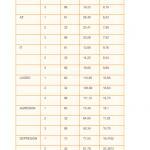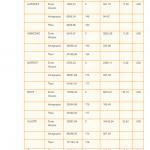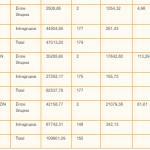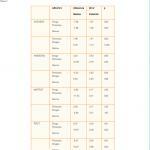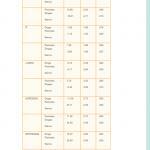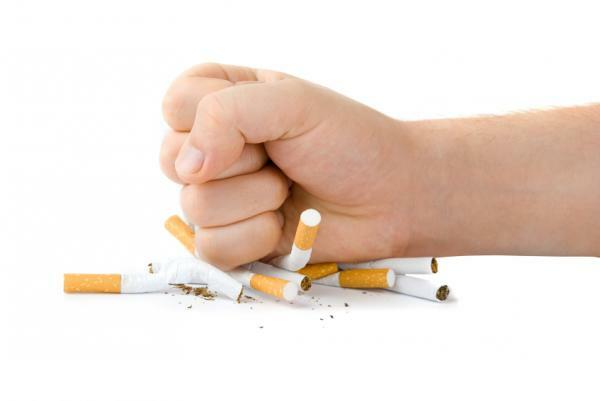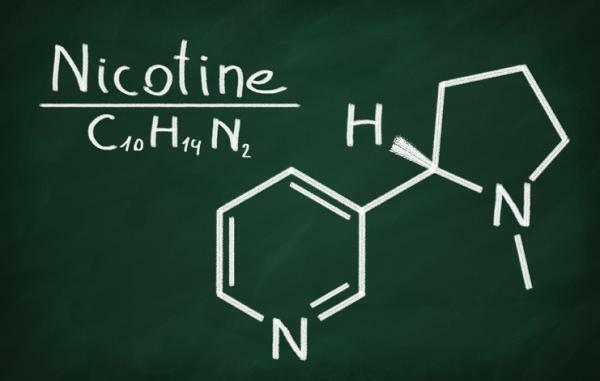
The pathological use of psychoactive substances it has become a serious public health problem (Evans, 1987), to the point that, at present, we speak of a pandemic (Thorne, 1985). The seriousness of the problem is accentuated by the difficulty of the treatment and the complexity of the rehabilitation process of the people who suffer it (Crowley, 1988; Harrison, 1994; Jones, 1995; Roback, 1996).
In this PsychologyOnline article, we will talk about Psychosocial profile of the drug addict (the CAIM case - Mérida).
Index
- Demographic data
- Drug addict behavior
- Method
- First results
- Results and comparison
Demographic data.
Some figures they can help illustrate the above. For example, Garbari (1999) points out that, in the United States of America, by 1996, the treatment needs were 5.5 million individuals for illegal drug use and 13 million individuals for alcohol use. Drug control programs went from $ 650 million in 1982 to $ 13 billion in 1997, all this without including tobacco and without mentioning the relationship between drug addiction problems with significant
In Venezuela (Garbari, 1999), the sociodemographic profile of the person who attends treatment for drug use is given by the predominance of the male sex (91%), 15 years 30 years of age (68%), single (74%), with incomplete high school education (65%), unemployed or unemployed (56%).
Regarding the habit of consumption, the person who attends treatment for drug abuse or dependence is characterized by the beginning of consumption between the ages of 10 to 19 (83%), daily use (38%), illicit starting drug cannabis (45%), secondary drug cocaine (59%), tertiary drug cocaine and crack (44%), drug of greater impact, cocaine and crack (85%).
According to Uzcategui (1998), the profile of the consumer of cocaine and its derivatives, treated at the José Félix Ribas Foundation, in Mérida, is characterized by an age of Onset ranging between 9 and 20 years (90.2%), being earlier in the case of females between 9 and 12 years (40%) than in males with an age of 13 to 16 years (44,1%). The most frequent starting drug is alcohol (80.4%) and the most general motivation for consumption is the invitation of a family member or friend (52.7%).
The most common place of starting consumption is their own community or home (71.5%), with a frequency of consumption of several times a day (41.1%). It impresses those who have worked with drug addicts of different nationalities and social classes, the consistency of some "characteristics" or "ways of being" of drug addicts in general.
Drug addict behavior.
For Yablonsky (cited by Luna, 1998), who has researched in this area for more than 35 years, the drug addict denies that he is in difficulty with the psychoactive substance (illusion of control); the family also tries to hide the difficulties, to deny them, clinging to the illusion that his relative is not a drug addict. The most systematic event is that the drug addict lies to himself. "The drug addict takes drugs to promise himself that he will not use drugs again." And when he accepts his difficulties in something in front of the substance, he begins to hold others responsible for his problems (victimhood). Another consistent event is that the drug addict knows what are the weak and strong points of each one of his relatives, data that allows him to manipulate or "blackmail" his environment to get what he wants. The drug addict has only one idea in his head and that is: How and when will I use again? Several authors call this irresistible desire "compulsion". Lying is something completely normal for the drug addict, he makes it part of his world, reaching the point of telling lies to himself. Maselli (1985) describes three periods in the development of drug dependence.
The first occurs from initial contact with the psychoactive substance, until the moment in which the teachers or parents find out about his hobby. This stage is called by some "the honeymoon", since the drug addict feels his relationship with the substance as "positive". The "escape", or moment of active effect of the substance, is an element that explains, to a large extent, the attachment to the psychoactive substance: For a short time, the substance makes the drug addict forget the problems and discomforts, keeping the "good" of the drug. substance. For some experts, the first period is rarely less than two years or more than four, a very relative data since it depends on the substance and the person. At some point the person tries to "break free" from the substance, but he realizes the difficulty in achieving this and begins to lie to himself. The second period appears with the public disclosure of the situation. This produces what might be called a family shock.
Denials, annulments, feelings of guilt and helplessness make their appearance. The drug addict begins to promise that he will quit the drug; the family believes in his promises and pleases him in his material needs, since he dominates the feeling of guilt. The family begins to experience ambivalent behaviors: gifts and aggressiveness to try to control deviant behaviors. A very complex pathology is then formed.
From the moment in which the relatives and, more rarely, the drug addict, they ask for specialized advice third period begins. In this last period, the family and the young person have overcome denial, self-deception, victimhood and are integrated into treatment. For their part, addicts, often family members, can sabotage treatment and prevent the drug addict from abstinence. Denial, on the part of the family, is usually the first obstacle in therapy. It is not accepted that the relative in question is sick.
After the denial, when the drug addict has been integrated into the treatment, in most cases comes a phase of aggressiveness of the family towards the drug addict. It is common to observe the appearance of new symptoms or strange behaviors, in some members of the family, when the drug addict is integrated into the treatment or is "being cured".

Method.
The evolution described so far has been based on predominantly foreign documentation and studies. Venezuelan research on the personal characteristics of the addict has been quite limited and this report represents an exploratory effort with the purpose of knowing some little explored aspects of the consumers of drug.
The questions we asked ourselves were three: Could there be a particular motivational profile of the drug addict? Are there differences between the self-esteem of the addict and that of the general population? Is it possible to establish some functional pattern of personality between the addict, as an isolated person, and the members of his close family environment?
Procedure With the close collaboration of all the staff of the Mérida Comprehensive Care Center (CAIM) of the José Felix Ribas Foundation, it was decided administer a multiscale or self-administered questionnaire, to all users of the Foundation's consultation, between the months of March to June 2000. In this way, a sample made up of 115 people, 73 consumers of psychoactive substances and 42 accompanying family members was obtained. It was not taken into account whether the people were regular or casual users of the service, or whether it was the first visit. Single it was verified that the person declared having problems with consumption illegal substances or had a family member affected by the problem. For the purposes of comparisons, we proceeded to select from the database of new admission to the University of Los Andes (2230 candidates from different specialties) a balanced random sample, by age and sex, to serve as a normative sample, assuming that this group represents the general population of the Merida region.
The multiscale is a Likert-type questionnaire of six points made up of a total of 153 items. It is made up of a set of subscales designed to measure Motivation for Personal Achievement (Romero García and Salom de Bustamante, 1990), Internality (Romero García, 1981), Psychological Normality (Esqueda Torres, 1997), Aggression (Escalante, 1995), Depression (Escalante, 1994), General Self-esteem (Rosemberg, 1979), Anxiety (Esqueda Torres, 1991) and Psychological Maladjustment (Esqueda Torres, 1997). In all cases, the subjects are asked to indicate the degree of disagreement or agreement they think they have with each of the statements that make up the multiscale.
In this way, it is possible to obtain a direct metric of the self-perception that the individual expresses in each of the measured dimensions. Results and Discussion To get an idea of the distribution of the results, the means and standard deviations are presented in Table 1, in each of the variables measured, not only for the group of drug dependent users (1) and the group of relatives (2), but the results of the sample have been added normative. groups.
First results.
Above all if it is borne in mind that the normative sample, It represents a very stable benchmark of observed variations in the general population regarding the variables under evaluation. The normative sample was randomly derived taking into consideration the size of the group surveyed in the Foundation, balancing age and sex, in such a way that there was no experimental bias in the comparisons. It is clear, from the summary analysis of the table of means, that the group of consultants due to drug addiction, compared with the normative group, systematically shows lower scores in self-esteem, psychological normality (NORTOT) and the derived measure of psychological adjustment (AJUST). Similarly, a higher score in anxiety, depression, psychological maladjustment (RTOT) and aggressiveness is detected for the same group.
A special comment deserves the comparison between motivational measures: total internality (IT) and achievement motivation (Achievement). The group of drug users (and that of relatives) appears with the lowest score in the measure of internality (the suggesting their strong tendency to externality or to the systematic external attribution of the events that explain their behavior); The same trend is observed when it comes to motivation to achieve. In this variable, as can be seen, the group of drug addicts and the group of relatives obtain a lower score than the normative group. This fact seems to suggest that internality and achievement motivation are variables that should be taken into account. consideration in therapeutic settings, when it comes to processes of recovery and social reintegration of consultants.
Even if it doesn't seem necessary insist on directly observable differences Among the group of consultants for drug problems, their relatives and the normative sample, it will be useful to highlight some interesting comparisons between the three groups. To do this, refer to Table 2, where the statistical information offered by an Analysis of Variance is summarized. (ANOVA), which allows establishing that there are significant differences between the three groups, in each of the dimensions measures.
* Editor's note: all tables are attached *
Results and comparison.
From the content of Table 2 it can be inferred that there are highly significant differences between the groups in relation to each of the dimensions measured. However, it is necessary to know which specific group differs or introduces greater variation in the scores for each variable. With that purpose in mind, a multiple comparison test was carried out, which is summarized in Table 3.
You can see that the group of drug users differs from the group of relatives, in a statistically significant way, in the measure of self-esteem, psychological maladjustment, aggression and depression. It can also be noted that in terms of aggressiveness, although drug addicts observe scores very high in relation to the normative sample, it is the relatives who show a level of aggressiveness higher. At such a level that they even differ statistically from their drug-impaired relatives. On the other hand, in terms of the motivational measures taken, there are no differences between the drug dependent groups and relatives.
Externality, that is, the tendency to consider that other agents or factors are the culprits of the personal experiences that they have had to live, it is the central descriptive characteristic for the two subsamples. Achievement motivation is low for relatives, but not substantially different from that observed in the normative population. However, this is not the case observed for drug addicts, who show statistically significant differences in relation to the normative sample. It follows, then, from the reported results, that the consultant for drug use is a person with low self-esteem, with severe general psychological maladjustment, high anxiety, depressed and aggressive. Likewise, the surveyed family members show high rates of anxiety and aggressiveness, probably associated with to the feelings of helplessness, guilt and helplessness produced by witnessing the progressive collapse of a being Dear.
An alternative interpretation that should be investigated later would be that, precisely, due to the high level of anxiety and aggressiveness, those relatives end up with an addicted, disorganized and depressed relative. Furthermore, it was found that motivational measures such as internality and achievement motivation do not suggest any particular pattern of expression (when both groups are compared); although it is clear that both drug addicts and their relatives are systematically more external than what is usually observed in the normative population.
In appearance, the perception of control of events is predominantly external because, taking direct responsibility for personal or family addicting behavior would be extremely costly in terms of the emotional commitment that this implies. It should be added, as a final consideration, that the present results represent a first approach to the study of the profile psychosocial of the user of psychoactive substances (consultant of the José Félix Ribas de Mérida Foundation) and of her relatives close. Obviously, more research will be necessary to respond to the concerns and questions that arise from this work.
This article is merely informative, in Psychology-Online we do not have the power to make a diagnosis or recommend a treatment. We invite you to go to a psychologist to treat your particular case.
If you want to read more articles similar to Psychosocial profile of the drug addict (the CAIM case - Mérida), we recommend that you enter our category of Addictions.
Bibliography
- Crowley, P. Family Therapy approach to addiction. Bull-Narc, 1988. 40 (1): 57- 62
- DSM IV Diagnostic and Statistical Manual of Mental Disorders. Masson, S: A., Barcelona, Spain, 1995
- Evans, R. Alcohol and Health. It is. From the Catholic University of Costa Rica, it is, 1987, 94-104,228.
- Freyberger, H., Stieglitz, R. Diagnostic Instruments and of Addiction. European Addiction Research. 1996, 2: 124-128
- Freixa, F., Soler, I. Drug addiction. A multidisciplinary approach. Human behavior, # 41, Barcelona, Spain, 1981
- Garbari, A. Classification, Epidemiological Aspects and Clinical Aspects of Addictions (presentation). I Update Conference on ADDICTIONS. Venezuelan College of Neuropsychopharmacology, Caracas, Venezuela, September, 1999
- Harrison, D., Chick, J. Trnds in alcoholism among male doctors in Scontland. Addiction. 1994, 89 (12): 13-17
- Jones T. The road to recovery. New law removes one barrier to rehabilitation for impaired physicians. Tex-med. 1995, 91 (8): 22-23
- Luna, J. What to do with an addicted child? 3rd. ed., San Pablo, Santafe de Bogota, D.C., Colombia, 1998
- Luna, J. Logotherapy an existential humanistic approach. 2nd. Es., San Pablo, Santafe de Bogota D.C., Colombia, 1999
- Maselli, B. Per Paura di vivere. Rome: Cittá Nuova, 1985, 52
- Pellicer, J. Psychological Studies and Clinical Scales for the evaluation of the addicted patient (presentation). I Update Conference on Addictions, Caracas Venezuela, September, 1999
- Roback, H., Moore, R., Waterhouse, G., Martin, P. Confidentiality dilemmas in group psychotherapy whith substance-dependent physicians. Am-J-Psychiatry. 1996, 153: 10,1250-60
- Rosemberg, M. (1979). Conceiving the Self. N.Y. Basic Books.
- Thorne, C., Deblassie, R. Adolescent subtance abuse. Adolescence. 1985, 20 (78): 335-347
- Uzcategui, C. The profile of the cocaine consumer, and its derivatives, in a group of users served by the José Félix Ribas Foundation in the city of Mérida (Thesis to opt for the Degree in Criminology), Universidad de Los Andes, Faculty of Legal and Political Sciences, School of Criminology, 1998
- Wing J., Babor, T., Brugha, T., Burke, J., Cooper, J. Giel R., Jablesnski, A., Regier D., Sartorious, N. SCAND: Schedules for Clinical Assesmen in Neuropsychiatry. Archives of General Psychiatry, 1990, 47: 589-593
Photos of the psychosocial profile of the drug addict (the CAIM case - Mérida)

